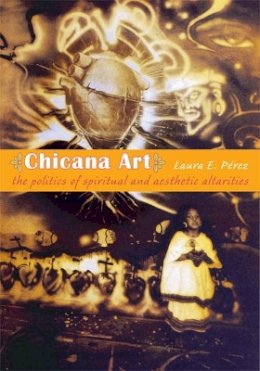
Chicana Art: The Politics of Spiritual and Aesthetic Altarities
Laura E. Pérez
Creating an invaluable archive, Laura E. Pérez examines the work of more than forty Chicana artists across a variety of media including painting, printmaking, sculpture, performance, photography, film and video, comics, sound recording, interactive CD-ROM, altars and other installation forms, and fiction, poetry, and plays. While key works from the 1960s and 1970s are discussed, most of the pieces considered were produced between 1985 and 2001. Providing a rich interpretive framework, Pérez describes how Chicana artists invoke a culturally hybrid spirituality to challenge racism, bigotry, patriarchy, and homophobia. They make use of, and often radically rework, pre-Columbian Mesoamerican and other non-Western notions of art and art-making, and they struggle to create liberating versions of familiar iconography such as the Virgin of Guadalupe and the Sacred Heart. Filled with representations of spirituality and allusions to non-Western visual and cultural traditions, the work of these Chicana artists is a vital contribution to a more inclusive canon of American arts.
Product Details
About Laura E. Pérez
Reviews for Chicana Art: The Politics of Spiritual and Aesthetic Altarities
Stephanie Nolasco
Feminist Review blog
“Pérez offers a rich analysis of a vast array of artistic works. . . . Pérez’s arguments are theoretically sound and always consistent with the organizing category of politicized spirituality. . . . Pérez’s notion of the politics of the spiritual as generative of tangible political and social effects is a critical contribution to the epistemological frameworks that inform Chicana/o studies and extends further to enrich this category’s management within art history, literary, and American studies.”
Victoria Fortuna
Aztlán
“The first book-length study of Chicana art, this long-anticipated volume surpasses expectation in breadth, depth, and presentation and begins to fill a noticeable gap in feminist scholarship. We applaud Duke University Press for having done an exceptional job in the production of this book. Beautifully designed, it is printed on heavy paper with high quality graphics and carefully chosen fonts. This high production value pays respect to the quality, depth, and diversity of the Chicana arts movement, which—as Pérez argues—encompasses a rich array of literature, essays, film, and fine arts including prints, silkscreen, painting, photography, murals, textiles, mixed media, digital art, conceptual art, and performance art.”
Luz Calvo and Catriona Rueda Esquibel
Signs
